From Superfortress to Banshee: Uncle Sam's four-engine cruise missiles
However, with all its merits, B-29 had one major drawback: it was not intercontinental. Its combat radius with a bomb load did not exceed 3000 kilometers. Formally, a heavy bomber could get from the American continent to Eurasia, but only at one end.
This American strategists did not suit. The experience of the war with Germany and Japan has clearly demonstrated that the Americans cannot rely all the time on the presence of bridgeheads near the enemy’s territory. Even with allies ready to extend their territory - which was not guaranteed - such forward bases could be swept away by a sudden attack by a well-prepared enemy, as happened with France in 1940 and the Pacific Ocean at the end of 1941. Pearl Harbor syndrome, the fear of a sudden crushing attack, deeply ate into the mentality of American society, and the destructive power of nuclear weapons only reinforced these fears. American strategists had to assume that a situation was potentially possible when the United States would have to strike across the oceans, directly from its continent.
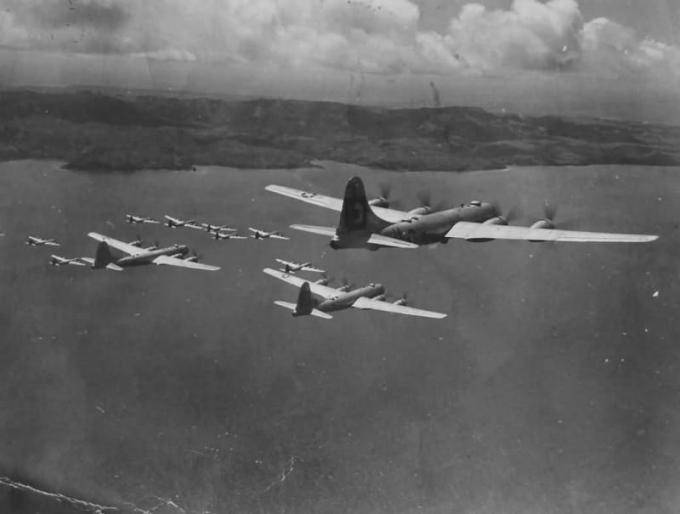
"Superfortressy" in combat construction. Uncle Sam really had something to frighten.
For such a scenario, the B-29 strategic bomber was unsuitable. Its range was simply not enough to get to Europe at least with a combat load and return back. The first truly intercontinental bomber, the enormous B-36 Peacekeeper, only flew in 1946, and it was still completely unclear when and in what quantity these extremely expensive vehicles would go into service. At the same time, the pilots also experienced fierce competition from fleetwho did not forget to remind everyone and everyone: decked aircraft from aircraft carriers can deliver nuclear attacks no worse than bombers. There was a very real risk that Congress could agree with the arguments of seafarers and reduce funding for strategic aviation. The Air Force urgently needed some kind of project that could “quickly and cheaply” solve the problem, even if only temporarily.
The idea was, in general, simple. If the B-29 does not have enough range to fly to Eurasia with a bomb load and return, then it means that it needs to be done so that it does not need to return - equip with an automatic control system and turn the bomber into a giant cruise missile on four piston engines. The experience of using unmanned aircraft and re-manned aircraft - into unmanned aircraft, the Americans did not have to occupy: during the Second World War, American companies produced tens of thousands of radio-controlled flying targets for training anti-aircraft gunners and fighter pilots. The American experience of using unmanned aircraft to 1946 year exceeded the rest of the world, taken together. Creating a giant projectile based on the B-29 capable of delivering an atomic bomb at one end across the Atlantic seemed quite possible.
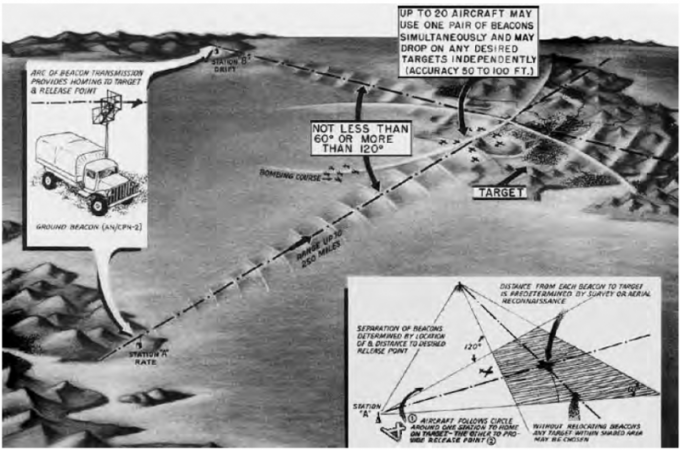
The project was based on the SHORAN (Short-RAnge-Navigation) automatic radio navigation system developed during the war, developed by Radio Corporation of America (RCA). The position of the aircraft in it was determined by triangulation along two ground radio beacons, the distances to which were determined by the delay in response to the signals of the aircraft’s transponder. An automatic oscillator triggered the aircraft’s transmitter at set intervals, and sent a short “beep!” Displayed as a luminous dot in the center of the navigator screen. The ground station received the signal, and immediately sent a response, which was displayed on the navigator screen with a second luminous dot, shifted away from the center of the screen. The distance between the points, determined by the calibrated scale, corresponded to the time delay of the signal - and, therefore, the real distance from the aircraft to the station. Having thus determined the distance to two stations separated by some distance, the aircraft navigator could triangulate its real position in space.
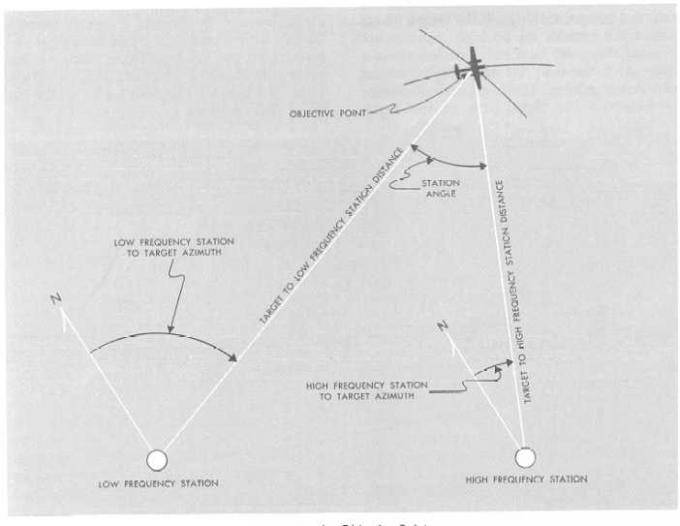
Schematic diagram of navigation using the SHORAN system.
First proposed in 1937, the system was brought to the attention of the then US Army Air Force on 1940, as a means of “blind” night bombardment. Experiments have shown that the system ensures the removal of the aircraft to the calculated point with an accuracy of 10 meters, at a distance of up to 500 km from the lighthouses. At first, American pilots (who preferred to operate during the day) were not particularly interested in the system, but as the conflict developed, there was a need for night operations. In the 1944 year, samples of the SHORAN system were deployed in Northern Italy, where they were successfully used for “blind” bombing of German facilities. The principle was simple: the target was located at the apex of the triangle, the base of which was formed by two SHORAN stations, and the distance from the target to each of the stations was known. All that was required of the pilots was to bring the aircraft to a point where the signal delay would have reached predetermined values (corresponding to the distance from the target to each of the SHORAN stations). After the war, RCA upgraded the system by introducing a direct mechanical measurement of the distance now displayed on the dial below the screen.
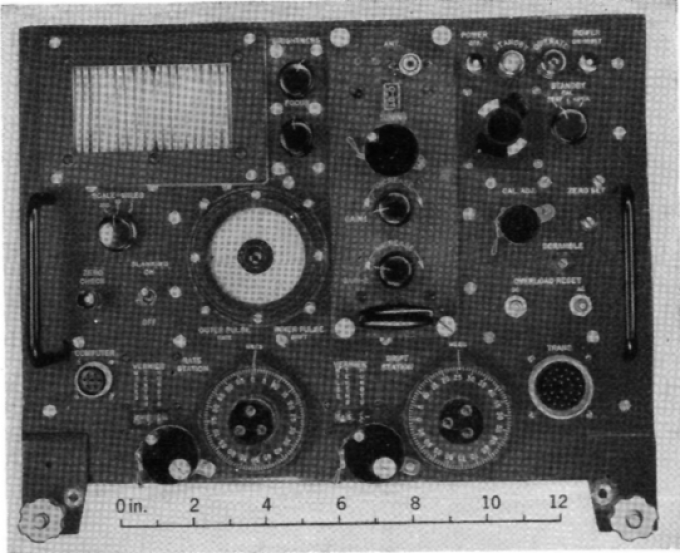
SHORAN side navigation panel used on B-29 bombers.
High accuracy and automatic operation of the system more than met the requirements of aviation. It seemed that all that was required was to link the SHORAN system with the autopilot, so that the plane could keep itself on the course without human intervention.
The project, which received the designation MB-29 (“M” - means “missile”, that is, guided projectile) and the code name MX-767 “Banshee”, was taken by a group of engineers led by former autopilot developer Al Palaia. They developed a system that automatically correlated the signal delay from the first and second stations SHORAN. In fact, the projectile kept itself on the bisector of the angle formed by the target and two SHORAN stations. Transponder signals from both stations, therefore, arrived on the plane with the same (constantly increasing, as the plane moved away from the stations) delay. If the signal delay, say, from the left station decreased, and increased from the right one, this meant that the plane deviated from the equisignal zone to the left. The automatics produced a mismatch signal for the autopilot, rejecting the rudders until the plane returned to the equisignal zone again.
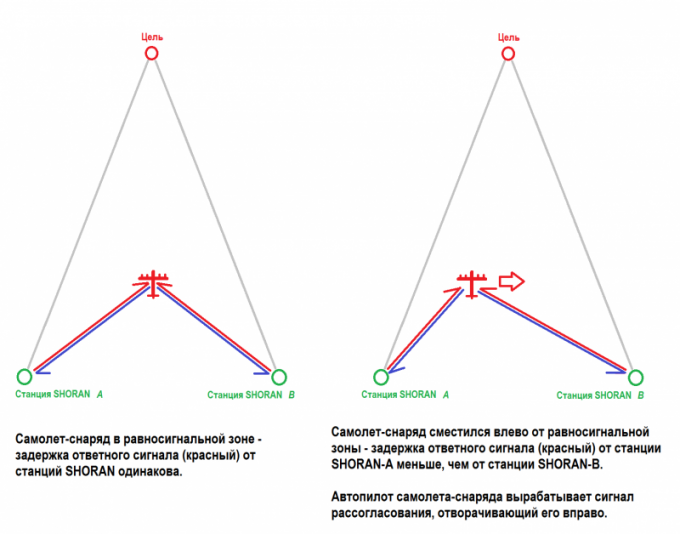
For unmanned aircraft control, the Palai group developed a special electromechanical computer that paved the plane. The computer took into account the following data:
• Current distance to ground radio beacons - continuously from the SHORAN system.
• Current heading - continuously from a magnetic compass.
• The ultimate distance from both SHORAN stations to the target is fixed, set before departure. Reaching the target value meant that the plane was above the target.
• The angles to both stations SHORAN - fixed, installed before departure.
Since this automation was not considered fully reliable, it was decided that the projectile would be output to the target area with a simpler radio command control from the escort plane. Once near the target, the crew of the escort plane transferred the projectile under the control of SHORAN and came back, while the giant flying bomb automatically went to the target.
In August 1946, the first test of an automatic system, mounted for experimental purposes on two old B-17 bombers, took place. Taking off from Hawaii, two MB-17 prototypes (accompanied by two DB-17 command and control aircraft) successfully flew to Myrock Field in California (now Edwards Air Force Base). On board both drones there was a crew, but its functions were limited only to takeoff and landing: the rest of the time, the MB-17 went either under the control of control aircraft, or automatically according to SHORAN beacons. The 2000-mile flight was a success, confirming the fundamental performance of the system.
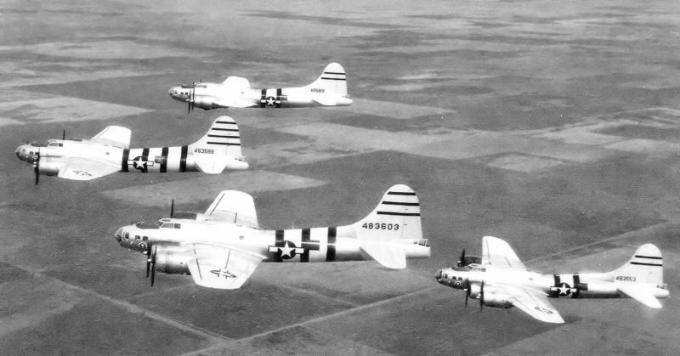
QB-17 unmanned bombers over New Mexico, 1946 year.
13 January 1947, the MB-17G projectile from the Experimental Guided Missile Group successfully performed a combat mission simulation. Having risen from the Eglin Field airfield in Florida, a shell plane, accompanied by a control plane, went as far as Washington, switched to the SHORAN system, and successfully “attacked” the American capital. The press, which covered the experiment extensively, was delighted - and did not stint generously pour the water of praises on the aviators' mill, fairly contributing to the formation of the US Air Force as an independent branch of the military in September 1947 of the year. What was even more important, the political elite of the United States was convinced of the principle operability of the very idea of long-range guided missiles.
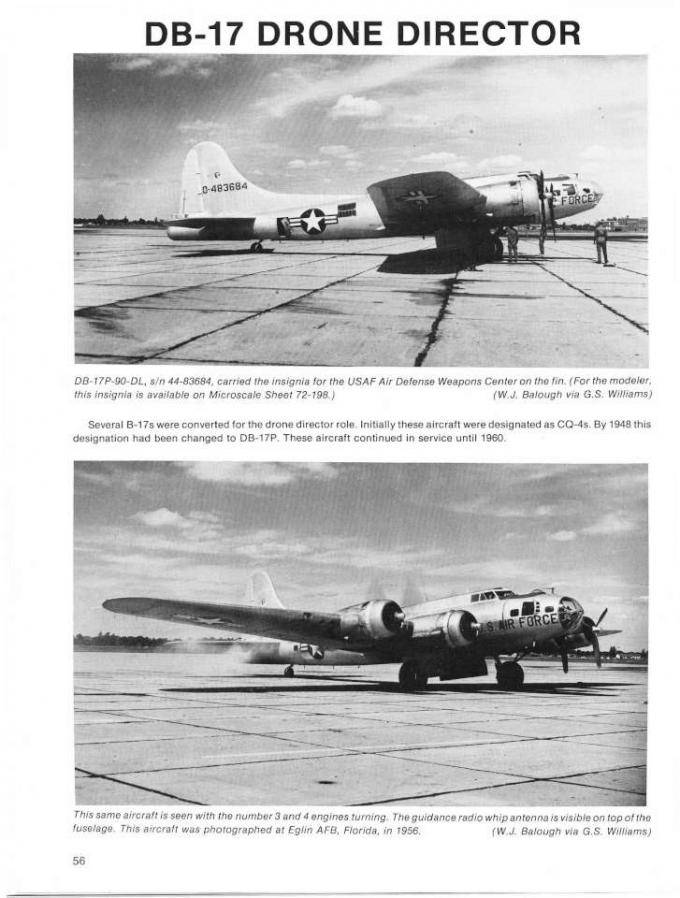
Control plane DB-17.
In the memorandum on unmanned aircraft approved by 27 on August 1947, the Banshee program ranked second in importance — priority was given only to the preparation of unmanned aircraft for taking air samples after nuclear testing.
However, a serious problem arose in the development of the system. The SHORAN system was not adapted for long-distance navigation. Its radius of action was limited to the curvature of the earth’s surface — that is, the Banshee projectile had to remain constantly in direct “visibility” of ground stations. For bombing operations at a distance of 500 km, this was not a problem, but it was not suitable for intercontinental operations.
As a solution to the problem, RCA offered to add ground stations with mobile “intermediate” transponders installed on the aircraft. The SHORAN ground stations were supposed to determine the positions of the beacons, and already the beacons - to determine, respectively, the position in the air of the projectile.
This, of course, required a significant complication of the system: if the coordinates of ground stations were constant and unchanged (and the signal delay from them too), then the beacons constantly moved and the signal delay from them constantly changed. The problem, in principle, could be solved using airships - but the aeronautical program was entirely under the control of the fleet, and the pilots knew perfectly well that seeking admiral assistance would be a de facto recognition of the lack of independence of the newly formed US Air Force.
Therefore, the problem began to solve a difficult way. On board the lighthouse aircraft, an entire system was installed, including:
* Search radar AN / APQ-13A, for fixing to a specific point of the surface under the plane.
* Position indicator AN / APA-44, to determine the exact position of the aircraft relative to the point recorded by the radar AN / APQ-13A.
* Electromechanical computer CP- (XA-19) / APN-56, for calculating the exact value of the delay in the response of the transponder to the calls of the aircraft-projectile.
* C- (XA-152) / APN-56 electromechanical relay, which introduced the computer-calculated delay into the transponder signal.
* Modified transponder AN / CPN-2.
It all worked as follows. According to signals from SHORAN ground stations, two lighthouse aircraft reached the pre-calculated “reference” points. Using the AN / APQ-13A radar, each beacon fixed a “reference” point on the surface — and then began to fly back and forth around the point. Moreover, his course coincided with the beam from the ground station SHORAN to the target.
During these air exercises, the position indicator AN / APA-44 determined the removal of the aircraft from the “reference” point, which was recorded by the AN / APQ-13A radar. Based on these data, the CP- (XA-19) / APN-56 computer calculated what the delay of the transponder response should be for the projectile to perceive the response signal as coming from the “reference” point. In effect, the computer simply added or subtracted several milliseconds to / from the standard signal delay, thereby compensating for the displacement of the aircraft from the fixation point. The range of the system was about 320 kilometers.
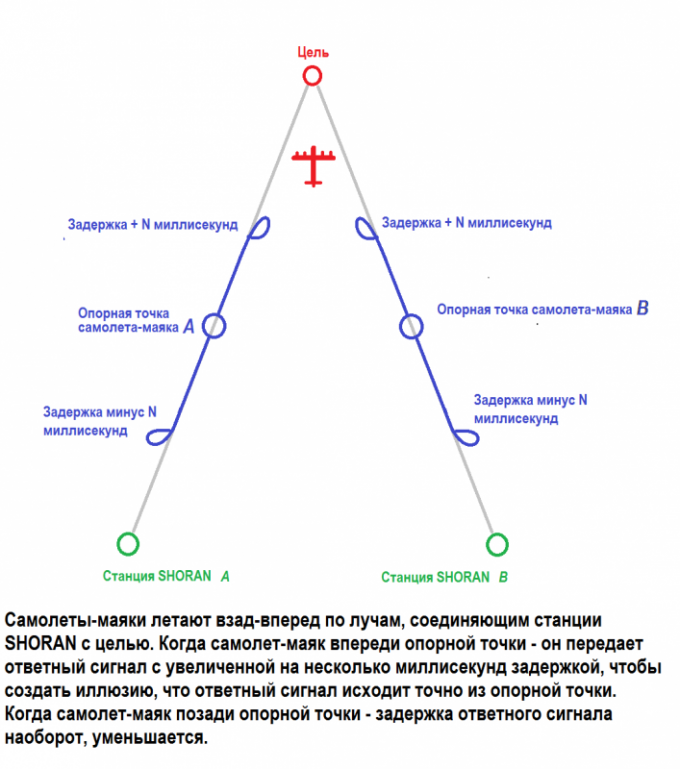
The system looked obviously over-complicated and a potential collector of problems, but there was no other way out at that time for the US Air Force. The Banshee project was at that time their only intercontinental delivery vehicle, potentially cheaper than the promising B-36 bombers. Namely, the issue of price was critical in the dispute over financing with admirals. The scheme of using “Banshee” now looked like this:
* A squadron consisting of a MB-29 projectile, a DB-29 control plane and two lighthouse airplanes was raised from an airfield and went together to the target.
* The projectile at the same time was under the control of the control plane.
* Having reached the established points, the beacons included their SHORAN transponders and began the above navigation maneuvers.
* The control plane transferred the shell aircraft under the control of SHORAN and returned to the base.
* The projectile continued to move under the control of the SHORAN system on the lighthouse aircraft. Course computer was responsible for navigation. When approaching the target, the K-1 computer bomb sight, which was responsible for dumping the combat load and calculating corrections for wind, speed and altitude, was automatically turned on.

Flight departure squadron chart from 4's aircraft.
The main drawback was the use of four aircraft in one sortie - and only one of them had to bear the combat load. In an attempt to solve this problem, the engineers offered several possible simplifications. The first of these boiled down to the idea of excluding a separate control plane, and transferring its functions to one of the lighthouse aircraft. In theory, this allowed the number of aircraft to be reduced by one; in practice, there were serious problems with switching from radio command control to SHORAN. For radio command control, the control plane was supposed to be close to the projectile, tracking it visually. But since in the proposed project, the control plane was at the same time a beacon, the moment inevitably came when the beacon had to move away from the projectile and take up a position.
Another proposed solution was to eliminate the radio command stage in general; the projectile had to go under the control of the inertial autopilot, and only the target had to go under the control of the beacons with SHORAN. This proposal also did not inspire aviators enthusiasm. At that time, inertial navigation systems were not perfect enough, and there was a considerable risk that an aircraft shell left unattended would manage to deviate in such a way that it would not enter the SHORAN triangle.
To test this concept, in November 1948, the B-29 aircraft that took off from Eglin airbase (California) went all the way to Oahu on the inertial autopilot E-4. Meteorological conditions on the way were unfavorable, and as a result, the autopilot error was more than 200 kilometers! According to the results of the experiment, aviators came to the conclusion that the “inertial” “Banshee” could work only under very good weather conditions, and this direction was also considered unpromising.
Finally, a solution was found in equipping one of the beacons with an additional impulse radio beacon, and installing a radio compass on the projectile. Now, the projectile automatically followed the beacon, focusing on its radio signals, and could be easily entered into the triangle of the SHORAN system. This concept was ultimately chosen as the main one.
The first alarm bell against Banshee rang in the second half of 1948, when the program found itself at the center of contractual contradictions between AMC (Air Material Command) and General Electric. Bureaucratic mismatch significantly slowed down the progress of work on the project.
The situation was further aggravated by the catastrophe of one of the experienced 6 projectiles in October 1948. The crew lifted the MB-29 into the air from the Robins airfield, but at an altitude of 20000 feet, one of the engines suddenly caught fire. In order to give the crew the opportunity to jump with parachutes, the pilot opened the doors of the bomb hatch, which under adverse weather conditions led to the stalling of the aircraft into a tailspin. MB-29 crashed near Waycross, Georgia; of the thirteen people on board, nine died - including three civilian engineers who took part in the equipment tests. This sad event was the first air crash that the US Air Force "for reasons of national security" hid a veil of secrecy - despite the protests of the relatives of the dead aviators.
However, the Banshee program continued. October 27 1948, the first successful MB-29 automatic flight took place under the control of the SHORAN air system. Switching from manual control to automatic was successful, and from that moment the Banshee flights became regular. At the end of December 1948, the first complete sets of equipment were finally received and assembled, and the program moved from the experimental stage to the practical development stage.
In February, 1949, began training flights. At this point, at various stages of readiness, there were seven aircraft re-equipped for the Banshee project:
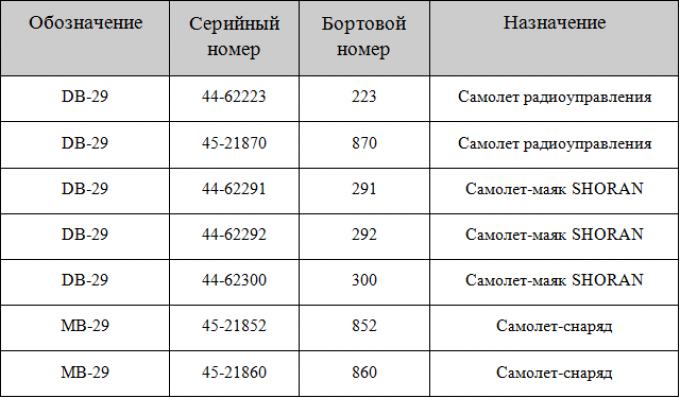
The last converted aircraft was delivered only on May 17. The first full-scale test - a fully automatic MB-29 flight over a long distance (albeit with a “safety net” crew on board), switching from radio command control to the SHORAN system - passed 7 on April 1949 of the year. And finally, the program 14 June 1949, met with the long-awaited success: having passed on automatic control, the MB-29 projectile dropped the atomic bomb weight simulator within the limits of the training target. Several more automatic flights were carried out in July-August, 1949, and the experimental group (renamed 550-th technical squadron of guided missiles) was preparing for the first fully unmanned Banshi flight scheduled in November.
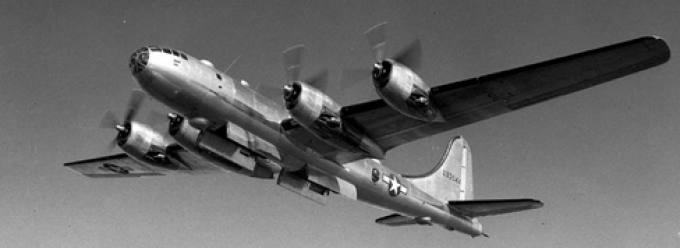
MB-29 Banshee (presumably) in flight.
October 3 1949, the commander of the 550 technical squadron recommended to stop work on the project “Banshee”. The main reason was the low technical readiness and low reliability of the program: out of twenty-four (24) flights in the summer of 1949, only four (4) were recognized as completely successful. Required for each departure of three aircraft and a whole set of sophisticated equipment, the system was extremely unreliable, very difficult to deploy and potentially vulnerable to counter the enemy (which was enough to drive one of the beacons from a position to completely disrupt the departure).
Of course, interdepartmental relations also interfered. The intercontinental strategic bomber B-36 “Peacekeeper” had already been successfully tested by that time, and was adopted for service. The United States Air Force no longer needed “cheap” palliative solutions. Moreover, since the beginning of the 1950s of the US Air Force, they began to distrust long-range guided missiles with great distrust, fearing that these “cheap” weapon systems would cast doubt on the need for manned - and very expensive! - bombers.
Information